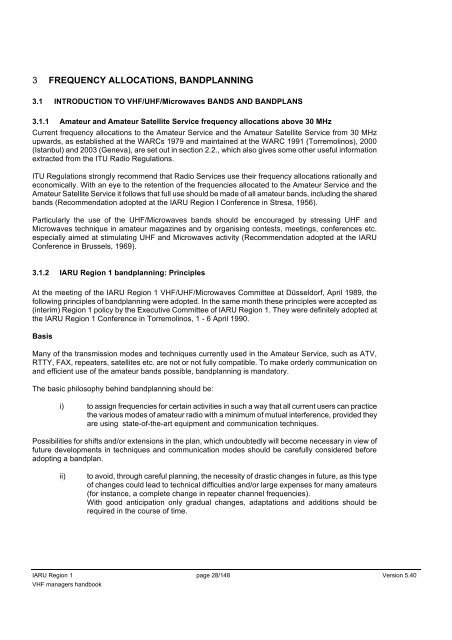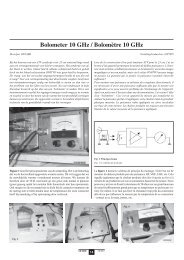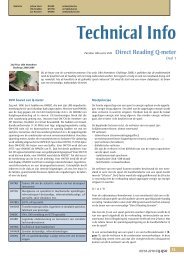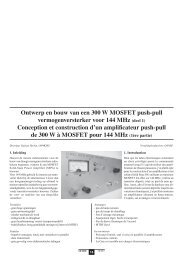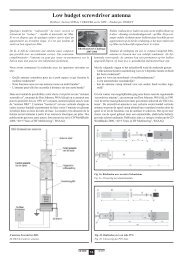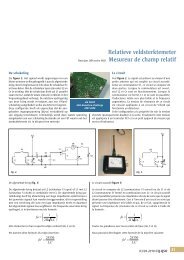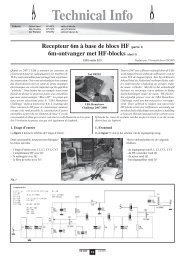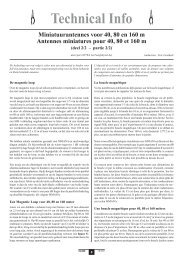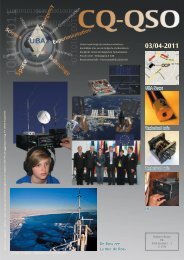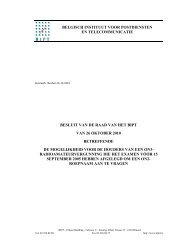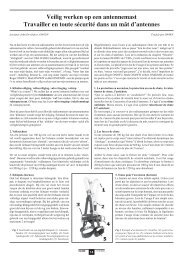IARU Region 1 VHF Managers Handbook - UBA
IARU Region 1 VHF Managers Handbook - UBA
IARU Region 1 VHF Managers Handbook - UBA
You also want an ePaper? Increase the reach of your titles
YUMPU automatically turns print PDFs into web optimized ePapers that Google loves.
3 FREQUENCY ALLOCATIONS, BANDPLANNING<br />
3.1 INTRODUCTION TO <strong>VHF</strong>/UHF/Microwaves BANDS AND BANDPLANS<br />
3.1.1 Amateur and Amateur Satellite Service frequency allocations above 30 MHz<br />
Current frequency allocations to the Amateur Service and the Amateur Satellite Service from 30 MHz<br />
upwards, as established at the WARCs 1979 and maintained at the WARC 1991 (Torremolinos), 2000<br />
(Istanbul) and 2003 (Geneva), are set out in section 2.2., which also gives some other useful information<br />
extracted from the ITU Radio Regulations.<br />
ITU Regulations strongly recommend that Radio Services use their frequency allocations rationally and<br />
economically. With an eye to the retention of the frequencies allocated to the Amateur Service and the<br />
Amateur Satellite Service it follows that full use should be made of all amateur bands, including the shared<br />
bands (Recommendation adopted at the <strong>IARU</strong> <strong>Region</strong> I Conference in Stresa, 1956).<br />
Particularly the use of the UHF/Microwaves bands should be encouraged by stressing UHF and<br />
Microwaves technique in amateur magazines and by organising contests, meetings, conferences etc.<br />
especially aimed at stimulating UHF and Microwaves activity (Recommendation adopted at the <strong>IARU</strong><br />
Conference in Brussels, 1969).<br />
3.1.2 <strong>IARU</strong> <strong>Region</strong> 1 bandplanning: Principles<br />
At the meeting of the <strong>IARU</strong> <strong>Region</strong> 1 <strong>VHF</strong>/UHF/Microwaves Committee at Düsseldorf, April 1989, the<br />
following principles of bandplanning were adopted. In the same month these principles were accepted as<br />
(interim) <strong>Region</strong> 1 policy by the Executive Committee of <strong>IARU</strong> <strong>Region</strong> 1. They were definitely adopted at<br />
the <strong>IARU</strong> <strong>Region</strong> 1 Conference in Torremolinos, 1 - 6 April 1990.<br />
Basis<br />
Many of the transmission modes and techniques currently used in the Amateur Service, such as ATV,<br />
RTTY, FAX, repeaters, satellites etc. are not or not fully compatible. To make orderly communication on<br />
and efficient use of the amateur bands possible, bandplanning is mandatory.<br />
The basic philosophy behind bandplanning should be:<br />
i) to assign frequencies for certain activities in such a way that all current users can practice<br />
the various modes of amateur radio with a minimum of mutual interference, provided they<br />
are using state-of-the-art equipment and communication techniques.<br />
Possibilities for shifts and/or extensions in the plan, which undoubtedly will become necessary in view of<br />
future developments in techniques and communication modes should be carefully considered before<br />
adopting a bandplan.<br />
ii) to avoid, through careful planning, the necessity of drastic changes in future, as this type<br />
of changes could lead to technical difficulties and/or large expenses for many amateurs<br />
(for instance, a complete change in repeater channel frequencies).<br />
With good anticipation only gradual changes, adaptations and additions should be<br />
required in the course of time.<br />
<strong>IARU</strong> <strong>Region</strong> 1 page 28/148 Version 5.40<br />
<strong>VHF</strong> managers handbook


